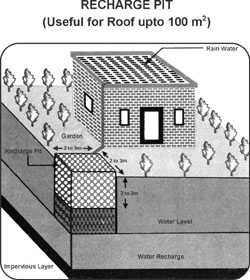Dec 13, 2025
Dec 13, 2025
Groundwater resource is depleting faster than the recharge. The problem has been compounded by a poor management especially in the urban centers. The State makes provision for drinking water supply yet in many parts of a town/metro people punch their own boreholes to enjoy, free, round the clock water supply. As has been oft repeated through these articles, groundwater reservoir is like a bank account. If several persons withdraw money from the same account without depositing anything they will be in the red soon.

Roof Top Rainwater Harvesting
Instead of only withdrawal if the joint account holders keep depositing small amounts regularly, their account will rather grow. Likewise Roof Top Rain Water Harvesting is like a small recurring deposit scheme. Every single drop of rainwater is carefully diverted to storage devices/groundwater reservoirs. Under normal circumstances rain water from the roof tops flows through the down-pipes to the ground and lost as a run-off. Somehow if this water is collected through a drain pipe along the perimeter of the roof and diverted to the structure where it has to be stored/utilized significantly large quantities of rainwater can be harvested.
How much water can be harvested this way can not be comprehended by a layman. The Central Groundwater Board (CGWB) has computed a table which depicts the volume of water available through rooftop harvesting:
| Rainfall (mm) | 100 | 200 | 300 | 400 | 500 | 600 | 800 | 1000 |
| Area of the Roof (Sq meter) | Rainwater available for storage/recharge (cu m) |
| 20 | 1.6 | 3.2 | 4.8 | 6.4 | 8 | 9.6 | 12.8 | 16 |
| 30 | 2.4 | 4.8 | 7.2 | 9.6 | 12 | 14.4 | 19.2 | 24 |
| 40 | 3.2 | 6.4 | 9.6 | 12.8 | 16 | 19.2 | 25.6 | 32 |
| 50 | 4 | 8 | 12 | 16 | 20 | 24 | 32 | 40 |
| 60 | 4.8 | 9.6 | 14.4 | 19.2 | 24 | 28.8 | 38.4 | 48 |
| 70 | 5.6 | 11.2 | 16.8 | 22.4 | 28 | 33.6 | 44.8 | 56 |
| 80 | 6.4 | 12.8 | 19.2 | 25.6 | 32 | 38.4 | 51.2 | 64 |
| 90 | 7.2 | 14.4 | 21.6 | 28.8 | 36 | 43.2 | 57.6 | 72 |
| 100 | 8 | 16 | 24 | 32 | 40 | 48 | 64 | 80 |
| 150 | 12 | 24 | 36 | 48 | 60 | 72 | 96 | 120 |
| 200 | 16 | 32 | 48 | 64 | 80 | 96 | 128 | 160 |
| 250 | 20 | 40 | 60 | 80 | 100 | 120 | 160 | 200 |
| 300 | 24 | 48 | 72 | 96 | 120 | 144 | 192 | 240 |
| 400 | 32 | 64 | 96 | 128 | 160 | 192 | 256 | 320 |
| 500 | 40 | 80 | 120 | 160 | 200 | 240 | 320 | 400 |
| 1000 | 80 | 160 | 240 | 320 | 400 | 480 | 640 | 800 |
| 2000 | 160 | 320 | 480 | 640 | 800 | 960 | 1280 | 1600 |
| 3000 | 240 | 480 | 720 | 960 | 1200 | 1440 | 1920 | 2400 |
 Statistically the figures appear quite amazing, but a lot depends upon the rainfall and geological, geomorphological and geohydrological conditions of the ground. The techniques have to be varied accordingly. Some of the techniques include:
Statistically the figures appear quite amazing, but a lot depends upon the rainfall and geological, geomorphological and geohydrological conditions of the ground. The techniques have to be varied accordingly. Some of the techniques include:
Recharge Pit
In the areas where thickness of alluvium or weathered rock is few meters only, underlain by a rocky substratum a recharge pit (see figure) is suitable. The pit is filled with gravel to act as a porous filter for water. This method is suitable for rooftops up to 100 sq m.
Image of Umbrellas under license with Gettyimages.com
Images by courtesy of CGWB
23-Jul-2006
More by : V. K. Joshi (Bijji)